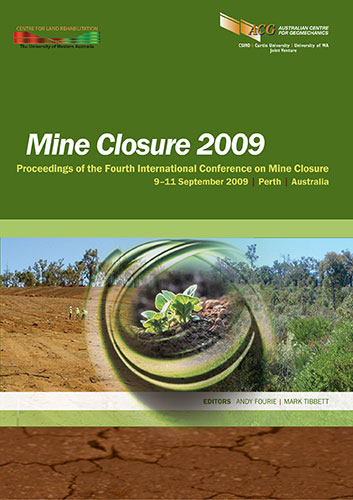Evoloving closure criteria throughout the life of mine

|
Authors: Koontz, DV |
DOI https://doi.org/10.36487/ACG_repo/908_18
Cite As:
Koontz, DV 2009, 'Evoloving closure criteria throughout the life of mine', in AB Fourie & M Tibbett (eds), Mine Closure 2009: Proceedings of the Fourth International Conference on Mine Closure, Australian Centre for Geomechanics, Perth, pp. 253-260, https://doi.org/10.36487/ACG_repo/908_18
Abstract:
Closure criteria is a term broadly used to describe an agreed standard or level of performance which demonstrates successful closure of a site (DITR, 2006). The development of appropriate and practicable completion criteria must be an evolving process over the life of a mining project based on the most up-to- date knowledge of site-specific conditions and the status of the operations. Regulators and other interested parties often expect that final detailed completion criteria, in some cases closure plans, can be developed at the initial environmental impact assessment (EIA) phase as a condition of approval. In reality, only broad closure objectives, design criteria and constraints, and conceptual closure activities can be identified at such an early stage of project planning as only limited information is available with regard to material characteristics and advanced design for post-mining landforms. The approvals process usually coincides with the later stages of feasibility studies to conform to overall development schedules. In many cases environmental approval needs to be confirmed before committing large sums of capital for a project to move forward with detailed design studies. At the definitive feasibility stage mineral resources have been identified, a preliminary mine schedule has been determined and process testwork has been completed to the point of providing a reasonable level of project design and cost estimate. However, there is still much work to be done in refining the detailed design. Telling the regulators what they want to hear to gain approvals, rather than setting the most appropriate criteria for the site-specific circumstances is usually counter-productive for long-term closure management. In such cases companies and consultants are often making their best guess at how the project will pan out and nominate de facto completion criteria which may ultimately be incorrect for the project outcomes. Experience has shown across many sites that the final post-mining rehabilitated landforms bear little resemblance to those originally defined by detailed completion criteria during EIA. This also discourages adaptive management which is defined as a systematic process for continually improving policies and practices by learning from the outcomes of operational programmes (DITR, 2006). This paper will consider the levels of detail for completion criteria which is appropriate for each phase during the life of a mining operation.
References:
Allen, B. (2000) Case Study 3 – Homestake, Proceedings of Seminar entitled Planning for Mine Closure – An
Operators Guide, 7–8 December 2000, Perth, Australia, Australian Centre for Geomechanics, Perth, S8, 9 p.
Australian and New Zealand Minerals and Energy Council and Minerals Council of Australia (ANZMEC and MCA)
(2000) Strategic Framework for Mine Closure, Canberra, Australia.
Evolving closure criteria throughout the life of mine D.V. Koontz
260 Mine Closure 2009, Perth, Australia
Department of Industry, Tourism and Resources (DITR) (2006) Leading Practice Sustainable Development Program for
the Mining Industry – Mine Closure and Completion, Canberra, Australia, 53 p.
Department of Mines and Petroleum (DMP) (1997) Guidelines for Safety Bund Walls Around Abandoned Open Pit
Mines, Government of Western Australia, Department of Industry and Resources, 14 p., viewed 20 June 2009,
International Council on Mining and Metals (ICMM) (2006) Good Practice Guidance on Mining and Biodiversity,
London, UK, S5.3.6, 71 p.
© Copyright 2025, Australian Centre for Geomechanics (ACG), The University of Western Australia. All rights reserved.
View copyright/legal information
Please direct any queries or error reports to repository-acg@uwa.edu.au
View copyright/legal information
Please direct any queries or error reports to repository-acg@uwa.edu.au